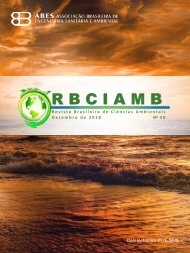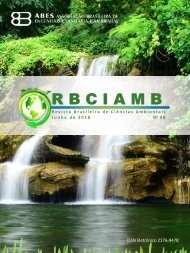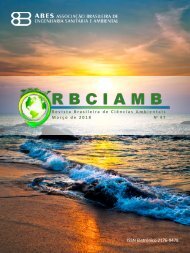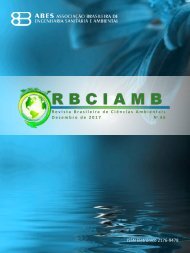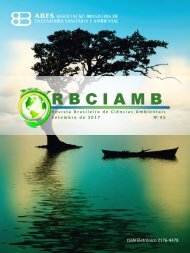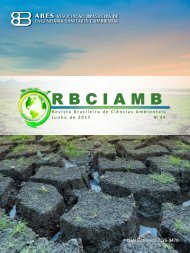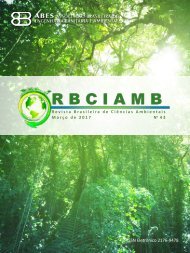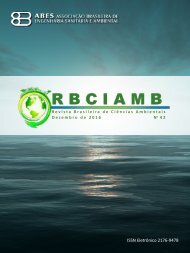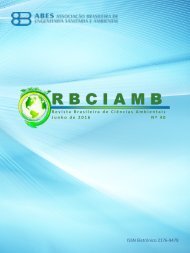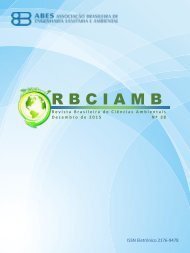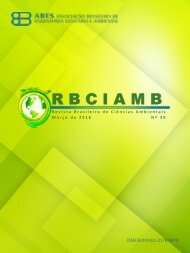EDIÇÃO 41 RBCIAMB
You also want an ePaper? Increase the reach of your titles
YUMPU automatically turns print PDFs into web optimized ePapers that Google loves.
Formulation of sediments with characteristics of tropical lotic systems for use in ecotoxicological assays<br />
on the natural sediment characteristics, as well as the<br />
commercial availability and ease of use in the laboratory.<br />
Further studies will be necessary to evaluate the<br />
interaction of different types of organic matter with<br />
contaminants, together with their influence on the<br />
bioavailability of toxic pollutants to benthic organisms.<br />
Tests of survival, growth, and reproduction of Hyalella azteca using sediment formulations<br />
Results of the ecotoxicological analyses provided support<br />
for the results obtained in chemical analyses of<br />
water for formulations 4 and 5. All the exposed organisms<br />
survived until the end of the experiments, and<br />
the values obtained for growth parameters were very<br />
similar, even in the comparison of the two formulations.<br />
The average weight and length values (using 10<br />
replicates for each formulation) are shown in Table 3.<br />
The minimum and maximum values obtained for the<br />
lengths of organisms were 2.07 and 2.67 mm respectively<br />
for formulation 4, and 2.09 and 3.<strong>41</strong> mm respectively<br />
for 5.<br />
Kruskal-Wallis analysis of variance test showed that for<br />
the length parameter there were no significant differences<br />
between formulations 4 and 5 and their control<br />
(p > 0.05). Additionally, for the average weight of the<br />
organisms, application of Fisher’s exact test revealed no<br />
significant differences between the test formulations<br />
and their corresponding controls (p > 0.05 in both cases).<br />
The reproduction parameter also showed considerable<br />
similarity between the treatments using the different<br />
formulations. The average numbers of offspring produced<br />
per couple at the end of two weeks (using five<br />
replicates for each formulation) are listed in Table 4.<br />
The smallest number was three offsprings (formulation<br />
4B), and the greatest number was 11 offsprings (formulations<br />
4C, 5A, and 5D). These results are similar<br />
to those of Fracácio et al. (2011), who found about 7 to<br />
11 offsprings per couple aging between 30 to 42 days.<br />
Kruskal-Wallis analysis of variance test resulted in p ><br />
0.05 for formulations 4 and 5 and between both formulations,<br />
therefore they suggest that there were no<br />
significant differences between the varied treatments<br />
in terms of numbers of produced offspring.<br />
Table 3 – Physiological parameters of the organisms after 10 days of contact with sediment formulations.<br />
Formulation Average weight (µg) Average length (mm)<br />
Control 4 0.123 2.300 ± 0.081<br />
4A 0.132 2.307 ± 0.061<br />
4B 0.136 2.276 ± 0.104<br />
4C 0.1<strong>41</strong> 2.386 ± 0.146<br />
4D 0.128 2.307 ± 0.147<br />
Control 5 0.138 2.280 ± 0.093<br />
5A 0.155 2.300 ± 0.084<br />
5B 0.143 2.438 ± 0.245<br />
5C 0.139 2.251 ± 0.118<br />
5D 0.132 2.266 ± 0.086<br />
Table 4 – Total numbers of offsprings produced per couple after 14 days of contact with sediment formulations.<br />
Formulation Control 4 4A 4B 4C 4D Control 5 5A 5B 5C 5D<br />
Average offspring<br />
per couple<br />
8.0 ± 1.0 8.0 ± 1.0 7.6 ± 2.8 7.2 ± 2.3 7.0 ± 1.2 8.0 ± 1.0 8.6 ± 1.5 7.6 ± 1.7 7.6 ± 1.1 8.4 ± 1.5<br />
9<br />
<strong>RBCIAMB</strong> | n.<strong>41</strong> | set 2016 | 1-11





